The genies on the stairs: stone carvings in the Fitzwilliam Museum, Cambridge
As you walk down the right-hand stairs from the old main entrance of the Fitzwilliam Museum in Cambridge, large stone figures loom at you from the walls (Image 1). Most people don't stop to look very hard. Those that do, often go away feeling none the wiser. So who are these figures and how did they get there? As we shall see, they made a 3000-year journey that began at Kalhu in the heart of the Assyrian empire, taking in Bombay, Eton College, and a possible case of theft.
The genies in the museum
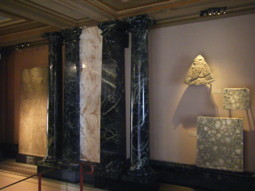
Image 1: The stone genies in situ on the main staircase of the Fitzwilliam Museum, Cambridge. Photo by Eleanor Robson, 2013. View large image.
The largest figure is carved in low relief TT on a dark grey marble TT . He's very muscular, with bulging arms and calves, standing larger than life at 2.3 metres high. He wears a sort of fringed kilt above the knee and a long cloak over his left shoulder, which falls to his ankles. Two handle-shaped objects peek out from the folds of his robe, and tassels hang down between his bare feet. He wears elaborate jewellery: a watch-like bracelet on his right wrist, a beaded necklace and dangly earrings. His shoulder-length hair and full beard are elaborately curled and he wears a rounded hat or headdress with a pair of bull's horns pointing forwards. Perhaps most strikingly, though, he sports a large pair of eagle's wings, down to mid-calf, and holds a small bucket in his left hand. In his raised right hand he clutches an object like a pinecone. What is he doing with it? We get the sense that this might be part of a larger image. And then there's the band of text running across the figure's midriff, written in wedge-shaped cuneiform script TT : the so-called Standard Inscription of king Assurnasirpal II.
» View large image of the muscular human figure in the Fitzwilliam Museum's catalogue
Further up the stairs is a very similar figure, but this one is kneeling. There are other, more subtle, differences too: there are two sets of horns on his headdress, torques TT and wristbands on both arms, twin handles under his armpit. The bucket and cone are disappearing off the left edge of the stone, while a series of plumes runs up the right hand side. There is the beginning of a further copy of the Standard Inscription at the bottom—and on closer inspection we can see that it has been cut off in the second line. The stone itself is a beautiful mottled pattern rather than the dull surface of the first, and at 80 cm high is about a third of its height.
» View large image of the kneeling figure in the Fitzwilliam Museum's catalogue
The third and smallest of the winged figures is also in a leftwards pose, with right arm up and left arm down. We can see his beaded necklace, fringed cloak and a torque on his right arm. But in place of a human head we see an eagle's face and a feathered crest running down the neck, augmented with shoulder-length curls. The remains of the Standard Inscription run across the top of the piece, which is made of a similar stone to the second one. At some 40 cm high, he is at roughly the same scale too.
» View large image of the eagle-headed figure in the Fitzwilliam Museum's catalogue
Accompanying them both is a triangular fragment showing a man's head, with the same elaborate beard and hair as the first two figures, a somewhat damaged hat and some quite spectacular jewellery. Across the hall, at the top of the left-hand stairs, is another larger-than-life male figure, in much the same style, but wearing sandals and a fez-like hat. He is armed with a ceremonial bow and sword and holds up a flat bowl in his right hand.
» View large image of the man's head in the Fitzwilliam Museum's catalogue
So the three genie TT figures are clearly closely related. They are carved in a similar but not identical style, in almost identical poses, and even carry the same inscription - or fragments of it in the case of the smaller pieces. It's quite clear too that all of them have been cut out from much larger sculptural contexts. So what were those contexts, and what do they tell us about what the figures represent?
The genies in the palace
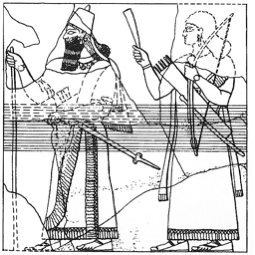
Figure 2: This modern drawing of Slab B-12 from Assurnasirpal's throne room shows where the head in Cambridge fits into the rest of the original design (Fitzwilliam ANE.3.1942). The lower part is still onsite in Nimrud, while the head of the eunuch TT is now in a private collection (1). View large image.
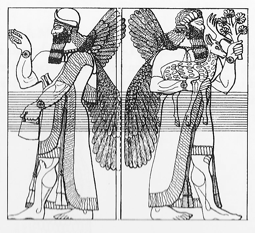
Figure 3: This modern drawing of Slab B-30 from Assurnasirpal's throne room in the Northwest Palace shows the Fitz's big genie (Fitzwilliam WAE.44.1927). He originally stood back-to-back with a genie bringing offerings, which is now on display in the British Museum (BM 124560) (2). View large image.
The fact that the genies all carry king Assurnasirpal's Standard Inscription — which he used only in the Northwest Palace at Kalhu and nowhere else — gives us the general purpose and context for which the Fitz's genies on the stairs were originally designed. But, thanks to detailed detective work by excavators Janusz Meuszyński PGP , Sam Paley PGP and Richard Sobolewski PGP (3), (4), (5) and art historians such as John Russell (6) and Klaudia Englund (7), we can go even better than that, and examine in great detail exactly which of the three sculptures belonged where, and what they signified in relation to the images around them.
The largest of the museum's genies, appropriately enough, comes from Assurnasirpal's throne room (Room B on the site plan), as does the head on the triangular fragment (8) (Figure 2, Figure 3). The genie sprinkles holy water on those entering the throne room from the western entrance from the outer court, along with another beneficent TT deity holding offerings. The head is that of the king himself, shown approaching the sacred tree TT and the winged disk TT of the god Aššur himself. He is ready to pay homage by pointing prayerfully at them both. This image stood immediately opposite the main entrance to the throne room, and was replicated behind the throne itself, on the short, eastern wall. The remainder of the walls were decorated with scenes of military victories, as befits the throne room of a successful warrior. It was, after all, the seat of power of the largest empire in the world at this time—the 9th century BC.
- View the layout of the reliefs from the throne room on the CDLI's website. The Fitz's genie is on panel B-12, the king's head on B-30.
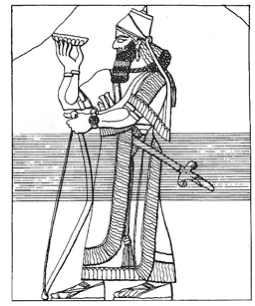
Figure 4: This modern drawing of Slab H-9 from Assurnasirpal's palace shows the armed king making a libation TT (Fitzwilliam WAE.45.1927) (9). View large image.
The rest of the Fitz's sculptures come from the reception suite just to the east of the throne room. As the site plan shows, this suite could be entered from three directions: from close to the throne in the throne room; from the central courtyard; and from the domestic quarters to the south. While Room G is relatively accessible, succeeding rooms are increasingly private. There is only one way in to Room H, which in turn gives access to the remaining rooms of the suite and there is no way out of the palace from here.
The decoration of the reception suite is very different from that of the throne room, which emphasised Assyria's military might. Rooms G and H show the king making libations TT - liquid offerings to the gods - in ceremonial military dress, protected and purified on all sides by human-headed genies, and with sacred trees protecting the dark corners. It is from the northern wall of Room H that the Fitz's large figure of the king originates (10) (Figure 4).
- View the layout of the reliefs from Room H on the CDLI's website. The Fitz's genie is on panel H-9.
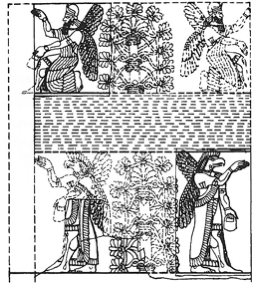
Figure 5: This modern drawing of Slab I-1 from Assurnasirpal's wash room in the Northwest Palace shows the Fitz's kneeling genie at the top left corner (Fitzwilliam ANE.2.1908). The standing eagle-headed genie at the bottom right is now in the Metropolitan Musem of Art, New York (MM 32.143.12). (11) View large image.
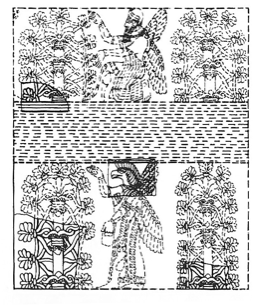
Figure 6: This modern drawing of Slab I-2 from Assurnasirpal's wash room in the Northwest Palace shows the Fitz's eagle-headed genie in the centre of the bottom register (Fitzwilliam ANE.1.1908). Fragments of the stylised tree are still on site at Nimrud (12). View large image.
Beyond H there are two L-shaped inner rooms, I and L, with the tiny Room K between them. Both I and L have two entrances each, along the long "leg" part of the room, while while the short "feet" both have tiled floors. Uniquely in this suite, the reliefs in Room I are carved above and below the Standard Inscription, not at full height. It is clear then, that the Fitz's smaller genies must come from here (13) (Figure 5, Figure 6). The upper panels all show kneeling, human-headed genies like the complete example from Cambridge, while the lower panels display standing, eagle-headed genies. The Fitz's eagle-head has been cut out of one such panel for shipment and display.
- View the layout of the reliefs from Room I on the CDLI's website. The Fitz's genies are on panel I-1 (top left) and I-2 (bottom centre).
Academics have hotly debated the intended function of this suite of rooms. All they have to go on is the scheme of images on the walls. The palace was excavated in the mid-19th-century, before the development of modern archaeological standards. Yet even if the palace had been excavated using modern methods, it is unlikely that such an excavation would reveal much about the rooms' intended functions. After all, they had been designed for a king and his entourage to live in, a function that had long since been abandoned when Kalhu finally fell in the late 7th century BC.
Maybe these rooms served as a banqueting suite; maybe they were a space dedicated to battle preparations, physical, mental and spiritual. For in Rooms G and H genies and eunuchs TT oversee the king as he makes repeated libation offerings over his ceremonial bow. The walls of the inner Rooms I and L have only genies and trees on them—full height in L, half-height in I. In other words, Room I is unusually densely protected by divine figures. The tiled floor of the "foot" allowed for water to be used here, while the narrow "leg" could be easily defended by bodyguards. It was, in other words, a safe space for the king, surrounded by discreet human and divine protectors. Here he could expose his body for ritual TT or practical washing without fear of attack, or being seen to be vulnerable.
Genies on the move (1): lost property
No amount of divine protection could prevent the eventual demise of the Assyrian empire. Even before the invasion of the Medes PGP and Babylonians PGP in the late 610s BC, Kalhu had lost some of its glamour and importance. Eventually the palace's roof collapsed and its formerly sumptuous halls filled with wind-blown dust and rubbish. Although the walls and their stone carvings remained upright, over the years and the centuries they disappeared from view, remembered only through myths of Nimrod, the mighty hunter (14).
When Austen Henry Layard PGP began work at the site of Nimrud in 1846, he focused on uncovering the palace reliefs. As he said to his sponsor Stratford Canning PGP in April 1850:
As for specimens all I could carry away should be a mere fraction in comparison with what remained. At Nimroud ... there is enough to fill twenty [British] Museums.
For better or worse, the sculptures first discovered by Layard have ended up in far more than twenty museums worldwide, some thanks to deliberate gift-giving by Layard, some as a result of later removal, and some, as we shall see, thanks to entirely unexpected circumstances.
We have seen above how in recent decades a great deal of work has gone in to discovering the current whereabouts of the reliefs and identifying their original locations. Geoffrey Turner PGP 's unpublished research has been particularly helpful in tracking the origins of the Cambridge sculptures, and we are very grateful to him and to Dr Lucilla Burn of the Fitzwilliam Museum for allowing us to access and use his work.
Shipping the sculptures from Nimrud to London was not straightforward. First the men on-site had to remove these huge stone objects from the ground, wrap them for protection, and manoeuvre them onto makeshift rafts. The rafts were sailed down the swift-flowing Tigris, where they were transfered to sailing ships. The next port of call was Bombay PGP - modern Mumbai in India - for British trade with Mesopotamia was still the monopoly of the famous East India Company TT . Only then, typically after a long-ish stopover and transfer to yet another ship, did the shipments head round the Horn of Africa for London. Mail and passengers could take the much shorter, partially overland route via Egypt but for freight this would be impossible until the completion of the Suez Canal PGP in 1869. The whole voyage could take over a year and there was plenty of opportunity for misadventure.
Layard's first four huge deliveries from Nimrud, sent in 1846, miraculously arrived unscathed at the British Museum. Everything that was unpacked matched the shipping lists that Layard had prepared in the field. The fifth cargo, which comprised objects from Nimrud and Nineveh PGP , set out in June 1847. It arrived safe and sound in Bombay in the spring of 1848 but there the trouble started (15).
Enthused by the discoveries at Nimrud and frustrated at their inaccessibility, the Governor of Bombay, one George Russell Clerk, ordered the shipment to be opened and put on public display. The editor of the Bombay Times, a Dr George Buist, even made plaster casts of the Black Obelisk and gave an impromptu lecture about it to the Bombay branch of the Royal Asiatic Society TT .
The Obelisk eventually made it back to the ship but not everything else did. When the shipment finally got to Britain in October 1848 — fifteen months after it had departed Nimrud — Layard was understandably furious to discover what had happened. He not only gave a full report to the Museum but immediately denounced the perpetrators in the preface of his forthcoming book, Nimrud and its Remains:
The cases containing the small objects, recently deposited in the British Museum, were not only opened without authority at Bombay, but their contents exhibited, without proper precautions, to the public. It is remarkable that several of the most valuable (indeed the most valuable) specimens are missing; and the whole collection is so carelessly repacked that it has sustained very material injury. Were these Assyrian relics, however valuable, such as could again be obtained, either by ingenuity or labour, their loss might not perhaps be so seriously lamented; but if once destroyed they can never be restored; and it must be remembered that they are almost the only remains of a great city and of a great nation. (Cheltenham, October, 1848) (16).
The next we hear of the missing sculpture is not until 1897, when a Miss Harriet Wainwright of Hoe Place, Woking PGP (a fine mansion that is now a public school), presented nine Assyrian stone fragments to the British Museum, all of which can be tallied with Layard's shipping list drawn up half a century before. If Miss Wainwright knew how those objects came into her family's possession she did not share that information with the British Museum, or the Museum did not record it.
However, a decade later another member of the Wainwright family—Harriet's younger brother George—yielded more information, along with more sculpture. In late 1907 or early 1908 he donated the two small genies from Room I to the Fitzwilliam, which kept records of the gift. The museum's accessions register records that:
These reliefs, with others, were used as decorations in a room built by the previous owner at [blank] where Mr Wainwright's father lived, when his family left there, the reliefs were divided among members of the family and other friends. Mr Birch PGP of the B[ritish] M[useum] saw them and at once recognised one piece as a fragment belonging to one of the reliefs in the BM brought over by Layard, he took it away and it is now attached.
According to George Wainwright, the Nimrud reliefs were already in Hoe Place when his father purchased it in 1870. When the Wainwrights sold up again in the 1890s, the family had decided not to leave the sculptures in situ but to divide them up. Harriet had given her share to the British Museum (but surely not to Samuel Birch PGP , former Keeper of Oriental Antiquities, who had died in 1885, but to the new Keeper of Egyptian and Assyrian Antiquities, the similar-sounding Mr Wallis Budge). As George explained in a letter to the Fitz's Keeper, M.R. James PGP , he preferred to donate to the Cambridge museum, as his niece was now married to its Egyptologist, a Mr Green.
The genies on the move (2): unwanted gifts
With an over-abundance of fabulous material at the British Museum's disposal, Layard was free to consider alternative recipients for a portion of the reliefs, especially if such gifts would benefit his project further.
At the end of that same letter to Canning quoted above, Layard added:
PS I mentioned to your Excellency before leaving Constantinople PGP that there were several fine bas-reliefs which had carefully reburied to preserve them from injury in case you should wish to have some specimens from Nimroud. There are now frequent opportunities of sending sculptures to England, and I only await your orders on the subject. I can select as many as your Excellency wishes and I will take care to have them sent to any place which you point out. The colossal figures are the best preserved and most interesting and should you still wish to present any sculptures to Eton College TT there are either detached figures or groups which will form very conspicuous objects in any Museum.
Canning finally wrote back, almost a year later, on 5 March 1851:
I willingly and thankfully avail myself of your offer, provided the objects be of sufficient importance. [...] The sculptures should be sent, if I have them at all, as might be presented to the University of Cambridge, for instance, or at least to one of its Colleges [...] if I did not wish to keep them for my own house.
A few weeks later, on 15 April, he changed his mind:
I wonder if you could get me two nice heads, a King and a Eunuch TT , the same as you got for [Lord] Cowley! I should like to have some monuments of Nineveh!
But by then it was too late to scale down the gift, for by the time the letter reached Layard, he had chosen a full-body king and genie as befitting the stately home of a grand patron or, perhaps, the great dining hall of an English seat of learning. His men packed them up and sent them by raft down the Tigris to Basra PGP , as part of a much larger shipment of finds destined for the British Museum which finally docked in London early in 1851.
Once the British Museum had checked that Canning's king and genie were "exactly similar to others already in the Museum", the sculptures were free to go to their new home. But it seems that Canning no longer wanted them—they were not the heads he had specified—so they were sent to Eton College as originally suggested. But after three-quarters of a century even Eton decided it had no need or room for them, and donated them to the Fitzwilliam Museum in 1927. Coincidentally or not, at that time Eton's provost was the same M.R. James who had been keeper of the Fitz in 1908 when George Wainwright had donated his genies. Perhaps he had it in mind to buy them together.
The changing meanings of the genies of Nimrud
As the genies of Nimrud have moved around the globe they have come to mean very different things to those who sought and possessed them.
In the 9th century BC they were protective, powerful, sculptural elements in a palace-wide scheme, designed to enhance the Assyrian king's prestige and and to protect him even in his most intimate, vulnerable moments.
In mid- to late 19th century southern England they became illustrations of British imperial endeavour as well as representatives of a once-powerful Biblical empire. Displayed now in the private homes of wealthy, well-connected men, or the institutions which educated the sons of those men, they were symbols of conquest and dominance. However, they were no longer seen as parts of a whole, but individual figures which conveyed their own authority, menace and might.
(At the same time, in other parts of the world, the genies represented different values, for instance by north American protestant missionaries.)
By the early decades of the 20th century the genies had lost their power to impress the imperial classes and were gradually handed over to museums for safe-keeping. Since then the slow process of recontextualisation has begun. There have been repeated attempts to recapture 9th-century meanings through documenting dispersal and regrouping images in print and online, even if the palace and its decor can never be reassembled in its original, stone-clad glory.
Content last modified: 18 Dec 2019.
References
- Englund, K., 2003. Nimrud und seine Funde: Der Weg der Reliefs in die Museen und Sammlungen (Orient-Archäologie 12), Rahden: Verlag Marie Leidorf, pp. 48 B-12. (Find in text ^)
- Englund, K., 2003. Nimrud und seine Funde: Der Weg der Reliefs in die Museen und Sammlungen (Orient-Archäologie 12), Rahden: Verlag Marie Leidorf, pp. 55 B-30. (Find in text ^)
- Meuszyński, J., 1981. Die Rekonstruktion der Reliefdarstellungen und ihrer Anordnung im Nordwestpalast von Kalḫu (Nimrūd), I: Räume: B.C.D.E.F.G.H.L.N.P. (Baghdader Forschungen 2), Mainz am Rhein: von Zabern. (Find in text ^)
- Paley, S.M. and R.P. Sobolewski, 1987. The reconstruction of the relief representations and their positions in the Northwest-Palace at Kalḫu (Nimrūd), II: Rooms I, S, T, Z, West wing (Baghdader Forschungen 10), Mainz am Rhein: von Zabern. (Find in text ^)
- Paley, S.M. and R.P. Sobolewski, 1992. The reconstruction of the relief representations and their positions in the Northwest-Palace at Kalḫu (Nimrūd), III: the principal entrances and courtyards (Baghdader Forschungen 14), Mainz am Rhein: von Zabern. (Find in text ^)
- Russell, J.M., 1999. The Writing on the Wall: Studies in the Architectural Context of Late Assyrian Palace Inscriptions, Winona Lake: Eisenbrauns. (Find in text ^)
- Englund, K., 2003. Nimrud und seine Funde: Der Weg der Reliefs in die Museen und Sammlungen (Orient-Archäologie 12), Rahden: Verlag Marie Leidorf. (Find in text ^)
- Englund, K., 2003. Nimrud und seine Funde: Der Weg der Reliefs in die Museen und Sammlungen (Orient-Archäologie 12), Rahden: Verlag Marie Leidorf, pp. 55 B-30, 48 B-12. (Find in text ^)
- Englund, K., 2003. Nimrud und seine Funde: Der Weg der Reliefs in die Museen und Sammlungen (Orient-Archäologie 12), Rahden: Verlag Marie Leidorf, pp. 95 H-9. (Find in text ^)
- Englund, K., 2003. Nimrud und seine Funde: Der Weg der Reliefs in die Museen und Sammlungen (Orient-Archäologie 12), Rahden: Verlag Marie Leidorf, pp. 95 H-9. (Find in text ^)
- Englund, K., 2003. Nimrud und seine Funde: Der Weg der Reliefs in die Museen und Sammlungen (Orient-Archäologie 12), Rahden: Verlag Marie Leidorf, pp. 106 I-1. (Find in text ^)
- Englund, K., 2003. Nimrud und seine Funde: Der Weg der Reliefs in die Museen und Sammlungen (Orient-Archäologie 12), Rahden: Verlag Marie Leidorf, pp. 107 I-2. (Find in text ^)
- Englund, K., 2003. Nimrud und seine Funde: Der Weg der Reliefs in die Museen und Sammlungen (Orient-Archäologie 12), Rahden: Verlag Marie Leidorf, pp. 106-7 I-1, I-2. (Find in text ^)
- Toorn, K. van der and P.W. van der Horst, 1990. "Nimrod before and after the Bible", The Harvard Theological Review 83, pp. 1-29 (PDF available via JSTOR for subscribers). (Find in text ^)
- Guha, S., 2015. "'Nineveh' in Bombay, circa 1840s: when the splendours of ancient Assyria enraptured the city", Scroll.in, 13 December 2015. (Find in text ^)
- Layard, A.H., 1849. Nineveh and its Remains, London: John Murray (free online edition at The Internet Archive). (Find in text ^)
Eleanor Robson
Eleanor Robson, 'The genies on the stairs: stone carvings in the Fitzwilliam Museum, Cambridge', Nimrud: Materialities of Assyrian Knowledge Production, The Nimrud Project at Oracc.org, 2019 [http://oracc.museum.upenn.edu/nimrud/livesofobjects/stonegenies/]